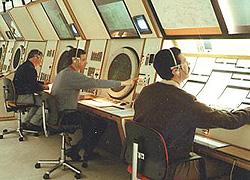This
console represents the 'third generation' of ATC radar display equipment. It was
the Air Traffic Control Autonomous Radar Display System (ATCARDS), later re-named
the Australian Computerised Air Traffic System (AUSCATS). This system, manufactured
by French company Thompson-CSF, replaced the earlier Bright
Display system in Melbourne, Adelaide, Perth, Coolangatta and Cairns from
the late 1980s.
ATCARDS was a radar data processing system which was able to perform simple functions such as SSR code/callsign correlation. The primary feature of this system was a fully-synthetic (i.e. computer-generated), stroke-drawn display which gave a very clean and crisp picture which was a pleasure to use. The computer-processed display enabled labels to be attached to tracks, as well as innovations new to Australian ATC such as the concept of 'jurisdiction' - i.e. the allocation of responsibility for a particular track within the system to an individual controller. One of the benefits of this was the ability to perform a 'silent handoff' of a track from one controller to another, thus improving efficiency by saving a considerable amount of voice coordination.
There was no flight data processing in the ATCARDS system, paper strips being used to record flight progress data.
The Museum's console is a later single radar console (early consoles were largely dual radar suites) which was in use in the Melbourne Area Approach Control Centre as Sector 12, a sector to the south-west of Sydney. The rows of buttons to left and right just above the desktop were intercom buttons - white for 'cold' lines and yellow for 'hot' lines. Below the radar screen is a keyboard for interacting with the computer and, to the right, a trackball which could be used to move a cursor about the screen. In the central area of the desktop are bays for the strips.
The monitor at top left is the RAPIC (RAdar PICture), which showed the Bureau of Meteorology's weather radar picture. The monitor at top centre was the EDDS (Electronic Data Display System), basically a PC on which could be displayed electronically a variety of useful information. At top right is a map display, in this case a section of the relevant En Route Chart - Low (ERC-L).
(Photo: CAHS collection)
